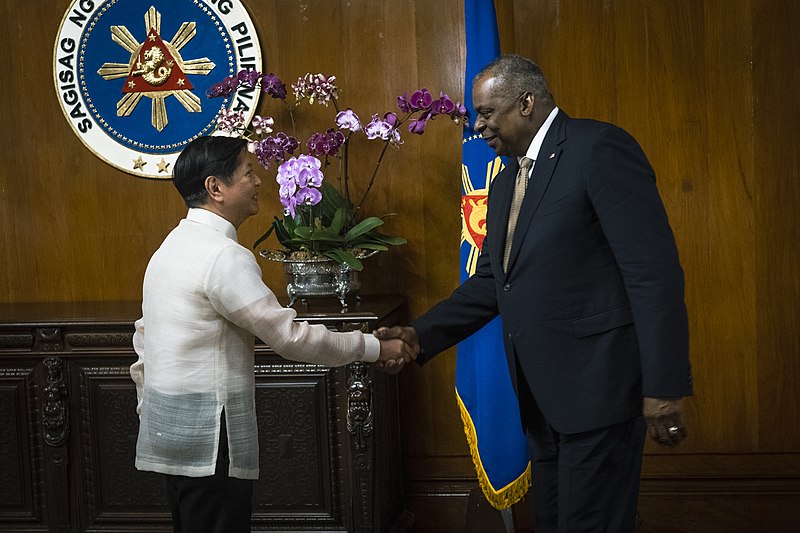Philippine President Ferdinand Marcos Jr. said the additional military bases under the country’s defense agreement with the United States would be in various parts of the Philippines. The US was granted access to four additional military bases at a time when China is increasingly asserting its claims over the disputed South China Sea and the island nation of Taiwan.
Marcos Jr. told reporters at the sidelines of the anniversary of the founding of the Philippine army on Wednesday that the four additional military bases the US were granted access to under the Enhanced Defense Cooperation Agreement would be in various parts of the Philippines. EDCA gives the US access to Philippine army bases for joint drills, prepositioning of equipment and building facilities but is not a permanent presence.
“There are four extra sites scattered around the Philippines – there are some in the north, there are some around Palawan, there are some further south,” said Marcos Jr. The four additional sites were granted last month on top of five existing army sites under the 2014 agreement.
Marcos Jr. said that Manila and Washington would announce the locations of the bases soon and added that the sites would bolster the Philippines’ ability to defend the eastern side of Luzon, its largest island. Luzon is also the closest Philippine island to Taiwan, which China claims as its territory.
A former Philippine military chief previously said the US has asked for access to army bases in Isabel, Zambales, and Cagayan in Luzon, as well as Palawan, the island closest to the disputed Spratly islands in the South China Sea, which Beijing claims the majority of as its territory. Some local government leaders of the potential EDCA sites have opposed the decision out of concerns that the country would end up involved in a conflict should there be one between the US and the Philippines.
However, Marcos Jr. said his administration has discussed with them the importance of expanding US access and how it would actually benefit their provinces.
Last week, a senior US admiral warned that the current situation in the Indo-Pacific region was “trending in the wrong direction” and reiterated that the US presence in the region was not an effort to contain or incite conflict with China. US Indo-Pacific Command leader, Admiral John Aquilino, also referred to remarks by Chinese foreign minister Qin Gang that “conflict and confrontation” are inevitable unless Washington changes its stance and stressed the importance of making known that the US was not looking for a fight.
“There’s a place for China in this world to adhere and follow the rules like all the rest of us do,” said Aquilino.



 Trump Sues BBC for Defamation Over Edited Capitol Riot Speech Clip
Trump Sues BBC for Defamation Over Edited Capitol Riot Speech Clip  Taiwan Political Standoff Deepens as President Lai Urges Parliament to Withdraw Disputed Laws
Taiwan Political Standoff Deepens as President Lai Urges Parliament to Withdraw Disputed Laws  Hong Kong Democratic Party Disbands After Member Vote Amid Security Crackdown
Hong Kong Democratic Party Disbands After Member Vote Amid Security Crackdown  European Leaders Launch International Claims Commission to Compensate Ukraine for War Damage
European Leaders Launch International Claims Commission to Compensate Ukraine for War Damage  Ukraine’s NATO Concession Unlikely to Shift Peace Talks, Experts Say
Ukraine’s NATO Concession Unlikely to Shift Peace Talks, Experts Say  Supporters Gather Ahead of Verdict in Jimmy Lai’s Landmark Hong Kong National Security Trial
Supporters Gather Ahead of Verdict in Jimmy Lai’s Landmark Hong Kong National Security Trial  Pakistan’s Army Chief Faces Gaza Troop Dilemma Amid US Pressure
Pakistan’s Army Chief Faces Gaza Troop Dilemma Amid US Pressure  Zelenskiy Signals Willingness to Drop NATO Bid as Ukraine, U.S. Hold Crucial Peace Talks in Berlin
Zelenskiy Signals Willingness to Drop NATO Bid as Ukraine, U.S. Hold Crucial Peace Talks in Berlin  Sydney Bondi Beach Terror Attack Kills 16, Sparks Gun Law and Security Debate
Sydney Bondi Beach Terror Attack Kills 16, Sparks Gun Law and Security Debate  Korea Zinc Plans $6.78 Billion U.S. Smelter Investment With Government Partnership
Korea Zinc Plans $6.78 Billion U.S. Smelter Investment With Government Partnership  Trump’s Rob Reiner Remarks Spark Bipartisan Outrage After Tragic Deaths
Trump’s Rob Reiner Remarks Spark Bipartisan Outrage After Tragic Deaths  Trump Weighs Reclassifying Marijuana as Schedule III, Potentially Transforming U.S. Cannabis Industry
Trump Weighs Reclassifying Marijuana as Schedule III, Potentially Transforming U.S. Cannabis Industry  U.S. and Mexico Reach New Agreement to Tackle Tijuana River Sewage Crisis
U.S. and Mexico Reach New Agreement to Tackle Tijuana River Sewage Crisis  Belarus Frees Opposition Leaders Maria Kalesnikava and Viktar Babaryka in U.S.-Brokered Deal
Belarus Frees Opposition Leaders Maria Kalesnikava and Viktar Babaryka in U.S.-Brokered Deal 































